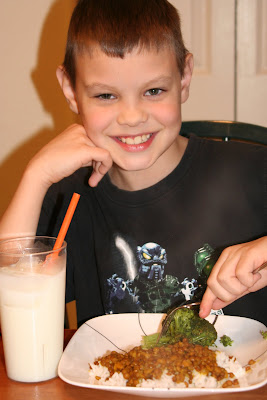
That's my nine-year-old in the picture, happily gobbling up a plate of dal, one of his all-time favorite dinners, and a menu staple in my house. Dal has a lot going for it. It's low in fat and calories, and extremely high in fiber, something most people get far too little of. I try to make at least one vegetarian meal per week for my family, so I like the fact that dal is meatless. The fact that it's meatless also means that it's extremely easy on the budget. And, it uses turmeric, a spice that's recently been found to help protect against various cancers. Besides all that, it tastes great, and the leftovers are good for lunch the next day, too.
Although I've tried others, I've been using this particular recipe for dal for at least 15 years, possibly longer. I found it in the back of a Good Housekeeping magazine at a time when ethnic foods were still pretty far off the radar for most people (including me). Something about its combination of spices sounded good, so I tried it (it was just me and my husband back then), and I've been making it ever since. I toned down the spices a bit when my kids were toddlers, but both of them have pretty much grown up on it. I make no claims as to the authenticity of the recipe, but a good friend of mine who spent several years in Fiji, a country with a large Indian population, also uses this recipe, and has said that it tastes more like the dal she remembers from Fiji than any other recipe she's tried. For me, it's enough that it's a healthy, meatless meal that I don't have to beg my kids to eat.
Oh, one more note. This recipe uses dried lentils -- the cheap, everyday brown kind that you find in a bag at the supermarket. If you want to go a little more gourmet, you can certainly try red lentils, or fancy green ones, but plain 'ole brown lentils are actually my favorite, as they give the recipe an earthy, robust taste. And, I like that fact that brown lentils become tender but still hold their shape -- smaller lentils or ones that have been cut will often fall completely apart as they cook, giving the dal a very different texture and consistency. If you want a creamier dal with a milder flavor, try yellow split peas instead of the lentils. Whatever legume you use, you really can't go wrong. Also, since fresh ginger wasn't readily available when this recipe was published, it calls for ground ginger. Feel free to substitute a couple of teaspoons of minced fresh ginger for the ground, if you have it on hand.
Finally, don't be put off by the rather long list of ingredients. Most of them are spices. Oh, and if you haven't used turmeric much, be careful with it. Turmeric is what gives curry that orange-yellow color, and it will stain things like rubber spatulas and plastic ware.
Dal (Indian Lentil Stew)
3 Tbsp. cooking oil
1 cup chopped onion
1-1/2 tsp. minced garlic
1 tsp. salt
3/4 tsp. ground coriander seed
3/4 tsp. ground ginger
3/4 tsp. ground cumin seed
1 tsp. ground turmeric
1/4 tsp. coarsely ground black pepper
1/4 tsp. red pepper flakes
1 bay leaf
1 cup dried brown lentils, rinsed
3 cups water
In a large saucepan or skillet, heat oil over moderate heat. Add onion, garlic, and all spices, including the bay leaf. Saute 5 to 10 minutes, stirring frequently, til onion is translucent. [It's really important to add the spices to the hot oil, rather than later, because heating the spices in oil is what releases their flavor.] Add lentils and continue to saute another 5 minutes, stirring often. Add water and bring to a boil. Cover pot; reduce heat to low and simmer for about 50 minutes, til lentils are tender and sauce has thickened. Discard bay leaf. Serve over hot cooked rice.
Makes 4 generous servings.
No comments:
Post a Comment